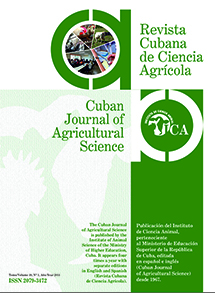Characterization of the temperature-humidity index and heat stress in dairy cattle in two dairy units in Mayabeque province, Cuba.
Contenido principal del artículo
Resumen
The influence of environmental factors in dairy cows was evaluated. A database that included twelve years (2005-2016) was used. The variables ambient temperature, relative humidity, rainfalls and temperature - humidity index in heat stress levels were studied. The INFOSTAT program was used for the analysis. The results show a high level of the average annual maximum temperature (30.2 ºC). The same performance showed the relative humidity (76.0 %), while rainfalls did not behave in the same way, and tended to decrease by 150 mm during the analyzed period. The average temperature - humidity index was 78 in the period 2005-2016, with marked contrast in its annual distribution. Between November and
March, the animals were in slight stress, as opposed to the June- September period, in which the values reached levels of 83, so the animals were exposed to severe stress conditions. During the study period, the average annual relative humidity in the research area was 76 %. Seven months maintained their average monthly value above this value (78 %). In general, an area with high relative humidity can be considered, which has its direct effect on thermal sensation and the temperature-humidity index, which considerably affects the animal welfare. It was proved that during the studied period (2005-2016) the cows were with a level from slight to severe heat stress in all months of the year, which could affect homeostasis and animal welfare.
Key words: stress, temperature, humidity, precipitations.
March, the animals were in slight stress, as opposed to the June- September period, in which the values reached levels of 83, so the animals were exposed to severe stress conditions. During the study period, the average annual relative humidity in the research area was 76 %. Seven months maintained their average monthly value above this value (78 %). In general, an area with high relative humidity can be considered, which has its direct effect on thermal sensation and the temperature-humidity index, which considerably affects the animal welfare. It was proved that during the studied period (2005-2016) the cows were with a level from slight to severe heat stress in all months of the year, which could affect homeostasis and animal welfare.
Key words: stress, temperature, humidity, precipitations.
Detalles del artículo
Cómo citar
Enríquez, A. V., & Álvarez Adán, A. (2020). Characterization of the temperature-humidity index and heat stress in dairy cattle in two dairy units in Mayabeque province, Cuba. Cuban Journal of Agricultural Science, 54(1). Recuperado a partir de https://mail.cjascience.com/index.php/CJAS/article/view/942
Sección
Ciencia Animal
Aquellos autores/as que tengan publicaciones con esta revista, aceptan los términos siguientes:
- Los autores/as conservarán sus derechos de autor y garantizarán a la revista el derecho de primera publicación de su obra, el cuál estará simultáneamente sujeto a la Licencia Creative Commons Attribution-NonCommercial 4.0 International (CC BY-NC 4.0) que permite a terceros compartir la obra siempre que se indique su autor y su primera publicación esta revista. Bajo esta licencia el autor será libre de:
- Compartir — copiar y redistribuir el material en cualquier medio o formato
- Adaptar — remezclar, transformar y crear a partir del material
- El licenciador no puede revocar estas libertades mientras cumpla con los términos de la licencia
Bajo las siguientes condiciones:
- Reconocimiento — Debe reconocer adecuadamente la autoría, proporcionar un enlace a la licencia e indicar si se han realizado cambios. Puede hacerlo de cualquier manera razonable, pero no de una manera que sugiera que tiene el apoyo del licenciador o lo recibe por el uso que hace.
- NoComercial — No puede utilizar el material para una finalidad comercial.
- No hay restricciones adicionales — No puede aplicar términos legales o medidas tecnológicas que legalmente restrinjan realizar aquello que la licencia permite.
- Los autores/as podrán adoptar otros acuerdos de licencia no exclusiva de distribución de la versión de la obra publicada (p. ej.: depositarla en un archivo telemático institucional o publicarla en un volumen monográfico) siempre que se indique la publicación inicial en esta revista.
- Se permite y recomienda a los autores/as difundir su obra a través de Internet (p. ej.: en archivos telemáticos institucionales o en su página web) antes y durante el proceso de envío, lo cual puede producir intercambios interesantes y aumentar las citas de la obra publicada. (Véase El efecto del acceso abierto).
